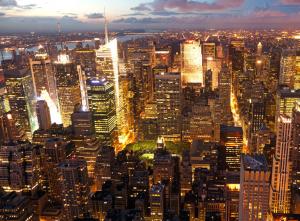New York City Sets Aggressive GHG Reduction Targets

Touting his proposal for lowering greenhouse gas (GHG) emissions as among the most ambitious in the nation, New York City Mayor Bill de Blasio announced last week that he wants large buildings within the city to be required to sharply decrease their carbon footprint over the next decade and a half.
According to the mayor's statement, if his plan is enacted by the City Council, New York will be the first city to mandate significant drops in building-sourced GHG emissions. In explaining the proposed move, the mayor referenced the effects of climate change, stating that "[t]ime is not on our side." He confirmed that even though President Trump has pulled the United States out of the Paris Climate Agreement, New York City intends to continue to abide by the accord's goals and objectives.
Noting that the fossil fuels used in providing heat and hot water in buildings represent the single largest source of GHG in the city, the mayor deemed it imperative that more buildings be retrofitted to accommodate more energy-efficient equipment, including not just furnaces, boilers, and hot water heaters, but also windows and roofing systems. Moreover, he said that such upgrades and improvements must occur over an accelerated timeline.
To that end, he asserted that the new standards would require those buildings sized at 25,000 square feet or larger to be significantly more energy-efficient by 2030. Mayor de Blasio stated that his plan builds on the "80 X 50" strategy the city adopted in 2014, which established a goal of reducing GHG emissions by 80% compared to 2005 levels by 2050.
The 2014 program was premised on an interim target of lowering GHGs emanating from buildings by 30% by 2025. The mayor averred that his updated plan will "frontload the most dramatic reductions into the coming decade." He commented that 14,500 buildings identified by the city as its worstperforming ones with respect to carbon emissions would be the initial focus of the program. The mayor reported that on a combined basis, those buildings were estimated to account for almost one-quarter of the city's current GHG emissions. He observed that one of the objectives of the plan is to bring those worstemitting older buildings closer to newer, optimally efficient buildings.
Aside from the obvious environmental and air quality attributes of the plan, Mayor de Blasio also listed a number of other benefits associated with the GHG reduction plan. In particular, the mayor said that as many as 17,000 "green" jobs could be created as a result of the plan and that consumers would see much lower energy bills as well. He maintained that higher-efficiency buildings will yield a decrease in natural gas use of at least 14% and an even greater reduction of 20% in fuel oil use.
Recognizing that the mere establishment of targets and goals is not always sufficient to incent adaptive behaviors, the mayor recommended in his plan that a schedule of penalties be imposed on those buildings that fail to show the progress necessary to effectively reduce GHG levels across the city. However, such penalties would not be assessed until 2030. In calculating the penalties, the mayor's plan appears to rely on a formula that is approximately two times the square footage of the subject premises. Thus, for example, a noncompliant 30,000-square-foot building would give rise to a penalty of $60,000 per year, while a building of one million square feet would engender a penalty of $2 million a year. The penalties would continue to be assessed for every year after 2030 that a building remains in noncompliance.
Acknowledging that the required energy-efficiency upgrades, improvements, and replacements could cause economic hardship for some property owners, especially smaller ones, the mayor proposed a mechanism termed a "property assessed clean energy" (PACE) program through which to ease that financial strain. The plan describes the PACE program as offering building owners the option of financing their energyefficiency projects through their city property tax bills. The mayor pledged that under his proposal, New York City not only would help finance up to $100 million in qualifying energy-efficiency projects each year, but also will provide technical assistance to all participants through the city's existing Retrofit Accelerator plan.
Lead image © Can Stock Photo / meinzahn



